My issue with Furi isn’t that it’s too hard. For a fast-moving action game entirely built around boss fights, a certain amount of exasperation is to be expected. My issue is that the game is too hard in the wrong ways and, perhaps, for the wrong reasons.
Furi, released yesterday for Steam and PS4 by the French indie studio The Game Bakers, offers a series of boss fights of escalating difficulty. There are no levels in between, no disposable cannon fodder enemies. Just you and the bosses. It’s a premise that is immediately compelling to fans of old-school beat-em-ups, nostalgic for the adrenaline rush of defeating inflated enemies. The premise is bound by a plot thin enough to account for an all-meat kind of game: You are an escaped prisoner fighting your way to freedom. At the outset, the game offers you two difficulty modes: “Furi (recommended)” and the easier “Promenade”. “Furi” isn’t coy about its difficulty: “The game is balanced to be challenging and demanding,” it confidently explains.
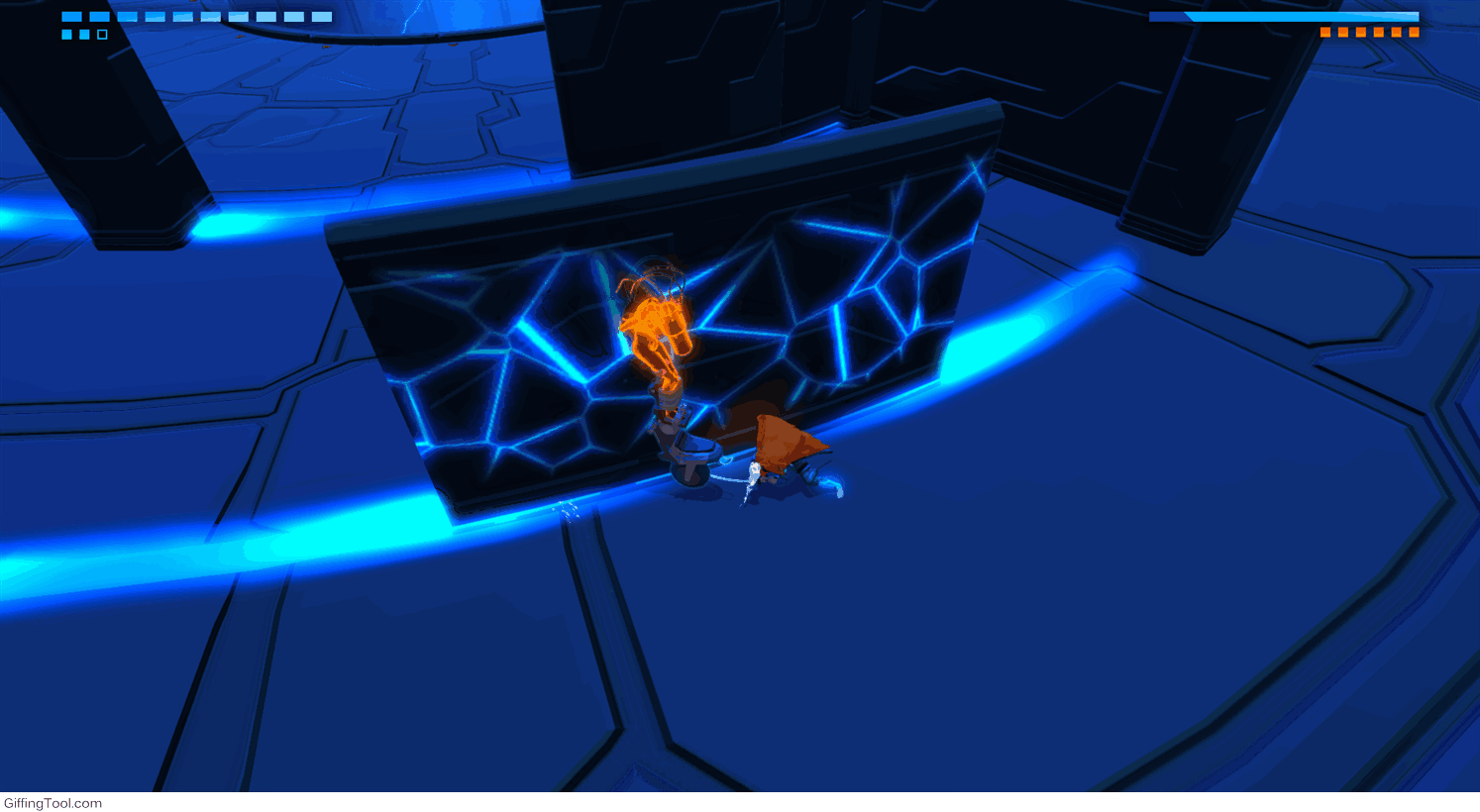
Later, if you defeat “Furi”, you’re offered “Furier”, described as “The true challenge for masters of combat”. After that, you can unlock “Speedrun” mode.
Although “Promenade” isn’t significantly easier than “Furi”, it does offer you more lives. You’re shamed for picking it, which made me wonder why it was included at all. Really, you’re not only shamed for picking it as much as you’re shamed for being the kind of person who would pick it: “Anyone will be able to enjoy the universe and the story, but the game will be much shorter and very easy. Does not unlock trophies, the Furier difficulty and the Speedrun mode.” After you select “Promenade”, Furi warns you again that you’re a wimp: “Are you sure you want to change the difficulty? It will prevent you from feeling the rush of combat… Once you have changed the difficulty, you can’t go back to the current difficulty.” Ouch. The word “Promenade” is a constant reminder on-screen that you’re not playing the game right.
OK, I thought, I get it. This is a hard game for real gamers.
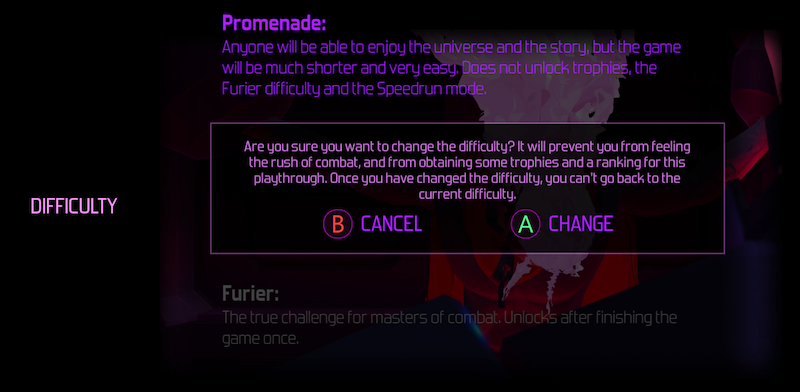
Combat is brutal. You can slash, shoot, parry and dash, mechanics that, for me, usually inspire a state of flow regardless of a game’s difficulty. The key, it seems, is memorising bosses’ animations and training your reflexes to adequately respond to their attacks. No problem — but the delay on your dash mechanic (intentionally, I’d imagine) makes it extremely difficult to time when dodging an area-of-attack blow.
Similarly, the window for parrying lasts only for a fraction of a split second, which is masterable if your reflexes are acute. These design choices assuredly are why Furi is billed as extraordinarily challenging, and yet, I wished that instead of a delayed dash or a too-quick parry, I was offered more opportunities for strategic rather than reflex-heavy play. On the second boss level, a maniacal, screaming female enemy manoeuvers around a maze, firing lasers at you. You’re forced on the defensive, hiding in the maze’s strategic nooks, while she occasionally hurls barely-announced attacks at you that you’ve never seen before. In moments like this, I couldn’t tell the difference between “balanced to be challenging” and “imbalanced, also challenging”.
Seven minutes of tedious walking cutscene between the fights wasn’t enough to cool me down.
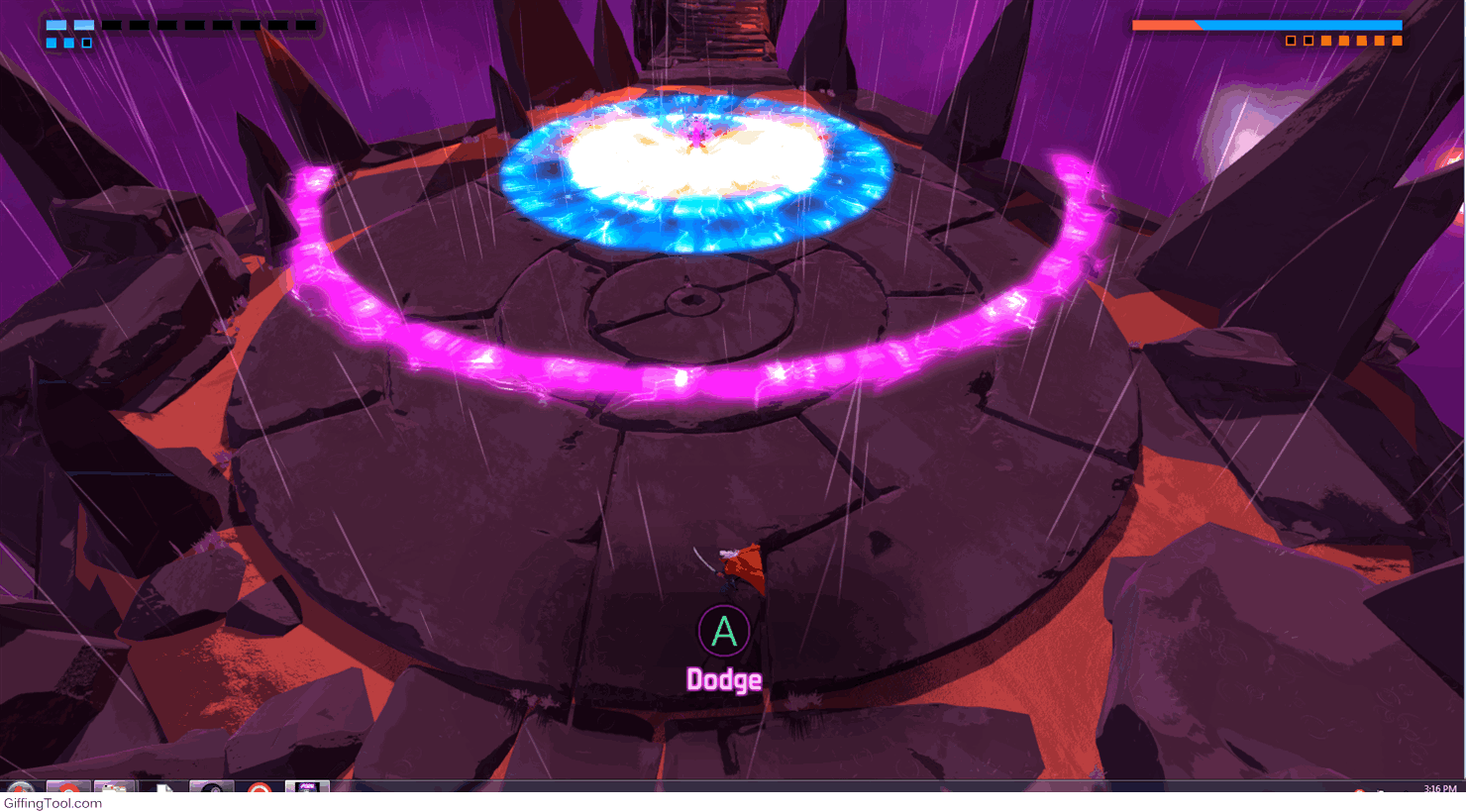
In more direct combat, if you land three successful slashes against an enemy, your character goes into an automatic attack animation. It’s a reward for rare successes, but also made me feel like I had less agency over my character. It’s distancing, but looks excellent.
As I played Furi, I kept thinking of Hyper Light Drifter, another demanding-by-design slash-and-dash game. HLD has similar combat mechanics but appears more indifferent to its own difficulty. Classier, really. When you die in that game, the music doesn’t even pause. The game’s menus don’t denigrate you for failing to meet its standards; it just implicitly asks you to try harder. And you want to. Furi, by contrast, antagonises players with its difficulty so unabashedly that I felt like it was consciously and specifically catering to gamers who like to brag about being good at hard games.
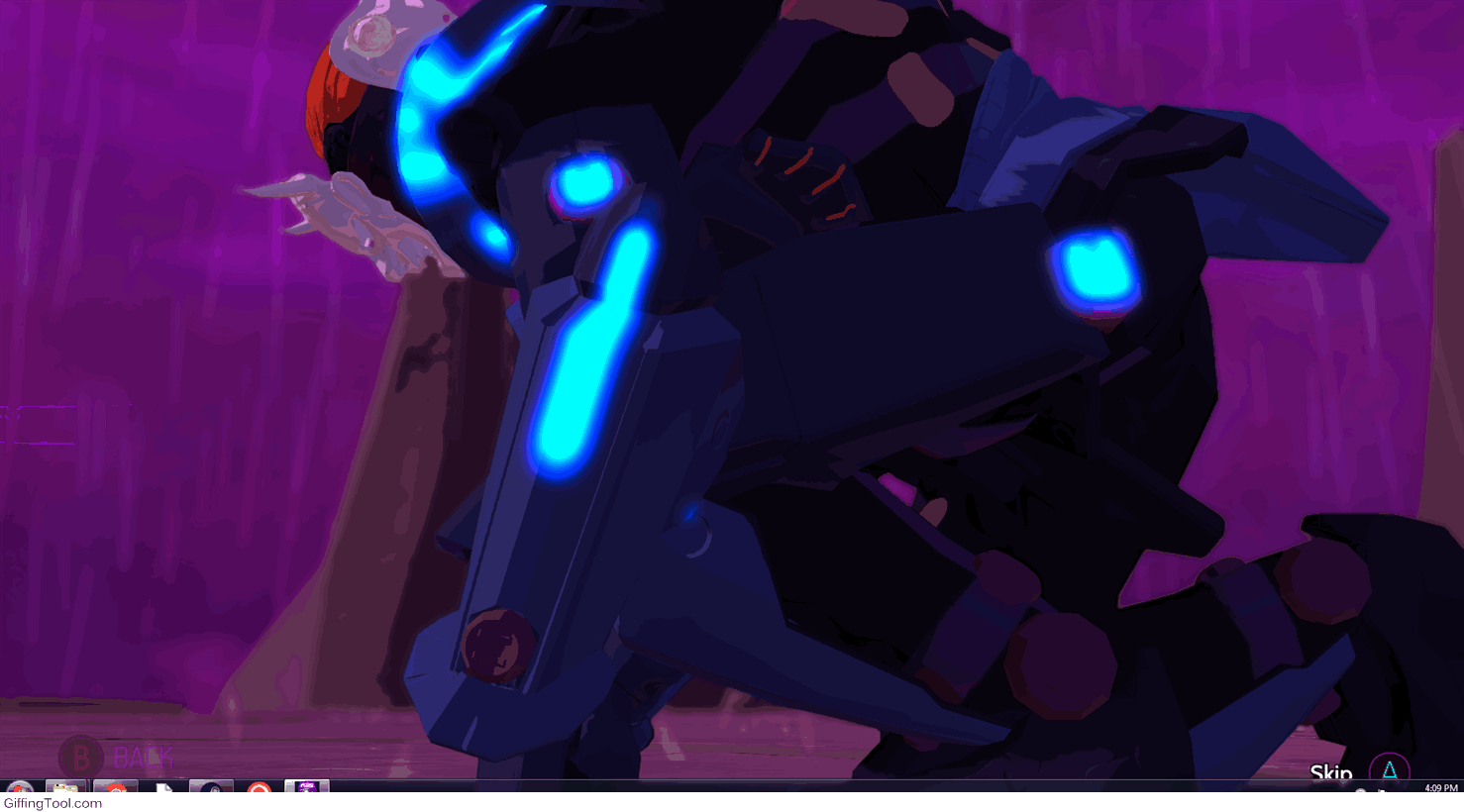
Each of the Furi‘s villains was designed by Afro Samurai creator Takashi Okazaki, and each one shines with his gift for character design. Their wildly fantastical appearances somehow aren’t enough to outweigh their repetitive dialogue: “And you think you can get out. Look at you. You’re a joke,” the first boss repeated a half dozen times to my limp corpse. “No way,” he said. “Let’s do this.” Still, Furi looks damn good, rich with purples and deep blues. The visuals are complemented by a vigorously synthy (and original) soundtrack composed by Danger, The Toxic Avenger and Carpenter Brut.
I wanted to love Furi. Its trailer begged me to recall the adrenaline rush I associated with my favourite boss fights from my youth, where dynamic and touching storylines added urgency to these one-on-one matches. But what I thought would be the game’s greatest draw — its promise of epic brawl after epic brawl — detached me from investing in my own success. I soldiered on if only to prove that I wasn’t a “Promenade” kind of gamer.
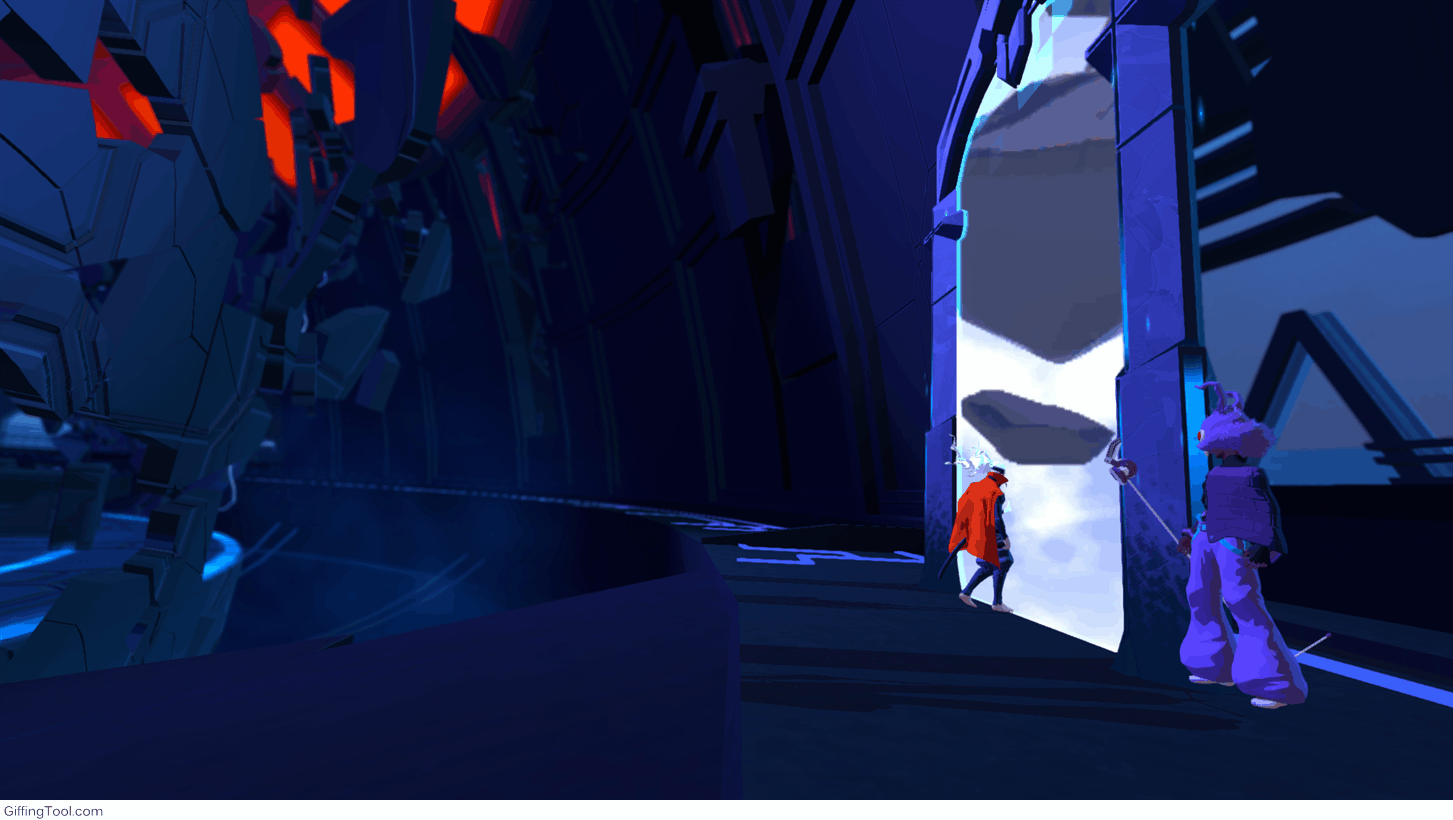
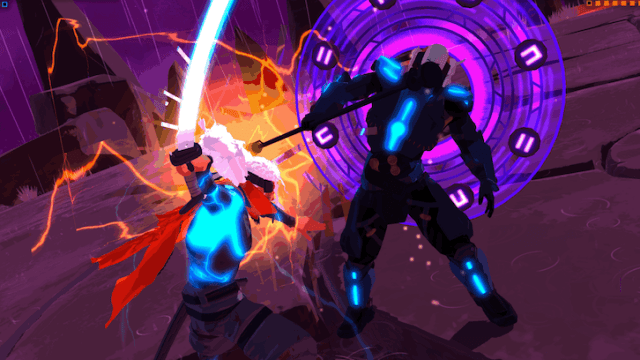
Comments
17 responses to “Indie Boss Battler Furi Is The Wrong Kind Of Hard”
Sounds like another time sink game in that you have to sink 20+hrs in order to become accustomed to how everything works and then you can actually play.
That’s all well and good as long as the game entices you and gives a reason why you’d want to spend 20+hrs to begin with….Personally I’d be happy to never hear about this again.
Ergggg this subject again, didnt we essentially go over this with Dark Souls? Dark Souls pretty much holds your hand compared to previous titles, yet it was still not enough.
I like to compare these games to bullet hell titles (heck the boss fights are pretty clearly inspired from them), these games aren’t for every one and I don’t see why they should be watered down or have their message changed (git gud).
There is a distinct difference between hard in a good way and hard in a bad way. You only need to look at Uncharted 3’s hardest difficulty vs. The Last Of Us’ hardest difficulty. The former is an infuriating slog with bullet sponge armies thrown at you, killing any sort of enjoyment to be had from the combat, and the the latter is the definitive way to experience the game.
Hard does not equal good. Good equals good.
Its a bullet hell game clearly… so yeah it plays like its meant to. Your standard action game this is not.
I haven’t downloaded it yet so I’m not position to comment. Just wanted to make clear that there is a difference between good hard and bad hard, even in traditionally punishing genres.
Then the whole bullet hell genre is a bad hard I guess and every one that enjoys it is a hard masochist.
Ironically, that’s a rather defeatist attitude. Things can always be made better, dogmatic thinking like “that’s the way it’s always been and that’s how it’ll always be” doesn’t get us anywhere. Look at the way the Souls series revolutionised rewarding difficulty. It can be done in every genre, if you’re smart and committed enough.
Its not defeatist as I actually enjoy bullet hell shooters like Raiden. I get so much satisfaction from beating a level that might have kicked my head in for hours on end before hand.
I understand that some people might not enjoy this type of game play, but I don’t think it should be watered down for the common denominator. It is an interesting design choice and one of many that I feel are threatened by the growing greed of publishers and their thirst for making the ultimate “every man” game.
Tldr` Niche games are great.
I’m not saying make it easier, I’m saying you can always make it better. Make it harder in more interesting ways. Make beating difficult tasks / enemies more rewarding, etc. Don’t water it down, just do it smarter.
Its a bullet hell, I don’t understand how you could make it smarter. Bullet hells are all about patterns that require precise control and timing. You don’t want to add any more mechanics or it throws out all of the rhythm.
Have you ever played games like Raiden, Type R or James town (to a lesser extent as it is still easier than eastern bullet hells by a large amount)? The games don’t need to be changed, you people need to stop trying to homogenise game genres and just accept that niche titles aren’t for everyone.
Its if tomorrow Mcdonald’s Australia brought out a burger that had been hugely popular in another region and a group of people (small or otherwise) that weren’t particularly used to said product were like “Hey, we don’t understand why there is only union relish on this burger, I want tomato sauce to be the standard”. The burger is perfectly good, its just that you aren’t used to the burger and while I am sure they are happy to make a one of burger for you that had what you want on it, they aren’t going to change something the people have been eating for a long time and have no reason to change other than to placate a bunch of people that are not likely to become routine consumers of said product.
The only direct example I can think of is Captain America. The far left screamed for diversity, Marvel folded. Four months later sales are much lower than they were before they catered to a group that largely weren’t their target audience to begin with. They quickly try to back pedal, but the damage has already been done; while sales do increase a little, the competitor that refused to budge (and funnily enough was losing before changes were made) capitalises on their competitor flailing about.
You can call it elitism if you want or you can take the time to realise that people just pride themselves in being able to play such games well and that watering them down will ultimately mean the death for a game genre that is very likely older than you or me (I am 27, cannot be bothered actually looking up how old bullet hells are).
This game… Jesus christ. I love Dark souls because it’s brutal but fair. You have complete control over your actions, with all the positives and benefits associated with that. You can wear heavy or light armour, use heavy (slow) or light (faster) weapons and again have all the consequences of those choices.
In Furi you only control how to react to the situations. If the game says the boss is in a not attackable phase (where he’ll parry any attempt at a direct strike, or simply instablink away (a mechanic the player doesn’t have, as their dash is VERY delayed so requires planned use) then you have to just wait and react to what he is doing, and when i say “react” what i really mean is you have to train your fingers to react on their own as the timings are so small that muscle memory needs to be doing it for you. You see a boss animation and by the time you’ve registered that thought, if your fingers haven’t already hit parry, you’ve been hit. The only way to deal meaningful damage to the boss is with parry counters, and the rest of the time it’s just chip damage.
I’ve honestly tried this game again and again trying to like it. I love the art style, I wanted to like the combat, and I love challenging but FAIR games. This is not one of them. Quite frankly this game is bullshit. It seems to think being bullshit is something to be proud of. We all know dark souls has some “oh what the fuck!?” moments, but it was a process of learning patterns in that and choosing how to react. In Furi, all you can do is play it over and over until your hands are trained in muscle memory well enough that you can parry. Parrying in Dark Souls takes skill and precise timing, and is so very satisfying when you pull it off. In Furi it is frankly unblievable the timing you need, and isn’t even satisfying when you do it, as the game makes it feel like the only way to deal proper damage, not a HUGE chunk of damage as a reward for a skillful play.
In short, fuck this game. I really, REALLY tried to like it, but just fuck Furi. There are much better games out there.
Only hard part of Dark Souls is the PvP. Just because it doesn’t hold your hand like the “press x to see where to go” mechanic in Bioshock or Dead Space, doesn’t mean it’s that challenging. Furi is just a much harder game. git gud <3
*Sigh* What happened to all the lovely folks who were able to say “This game is awesome, but sadly it seems I’m not skilled enough with this kind of gameplay for me to enjoy it”
Not every game is for you. For example, the Touhou series looked interesting to me, but just looking at the gameplay footage not only intimidated me, but It made me even not want to find out if I can beat it or not. Why? Because to me it looks like you’re playing the extreme hitboxporn-version of operation while trying to hit something, and I felt like that’s not my kind of gameplay.
Do I say “fuck Touhou”? NO. It’s beautiful, I love the soundtrack, and it appears to be a good game
—-It is just not for me!—
Maybe you commented this while still in a state of salt (and i realize this is old), but spreading misinformation is not the way to go.
So let me just correct you on some things:
*”timings are so small that muscle memory needs to be doing it for you.”
Err, speak for yourself, please. There are audible cues, and once you know a pattern, you might not even need them, if you can remember the timing instead. Which brings me to the next point.
*”I love challenging but FAIR games. This is not one of them. Quite frankly this game is bullshit.”
I find the game gives you enough health to be able to adapt to each attack (this bit is just my oppinion though, unlike the following facts:), and when you do, you get health BACK. Each parry heals you, destroying the bosses’ green projectiles yields health, You are healed to full health after each phase.
So what if you die? Everything that comes at you then -up to the point where you died- is something you have already seen, and beating a phase even gives you a life back! HOW IS THAT NOT FAIR!?
*”The only way to deal meaningful damage to the boss is with parry counters.”
Well guess what, I’m doing a no-parry-run right now and THE only situation i have encountered that makes parrying necessary is that one phase of the tutorial boss that teaches you how to do it. It’s a risk-reward thing with the healing you get, but all you really need to do is not get hit, and you will be able to counter. Sometimes dodging is easier.
“the rest of the time it’s just chip damage.”
Charged shots, charged slashes, melee combos. all of those can knock the boss down. If you hit a boss at the right time with an uncharged melee attack, they more often than not become stunlocked for the whole combo. And if you have good aim (which I don’t) using a machinegun-like salve of your regular blaster can outdamage charged shots in a lot of situations.
Special tipp: Hitting with a charged slash will always yield one of those riposte-attacks where the boss has an orange circle under them.
Tl;dr (not really)
10/10 nice salty facts, game proven impossible to beat, would uninstall again.
Scratch that bit with the no parry run, it’s not a thing. That being said, normal melee combos of the bosses are all dodgeable without the necessity of parries, some of them even without dash, too.
Honestly sounds a bit masochistic.
I fall firmly in the “Promenade” category of gamer, and I don’t really like being chided like that, so I won’t be picking up this game anymore. Shame, it looked so pretty. Thanks for the article Cecilia 🙂
I’ll give it a go as it’s on PS+, but I agree, why include an easy mode and then fake fun of you for choosing it? (I play easy mode on most games these days)
You know I’ve kind of been thinking about difficulty settings a lot lately, as I played Doom. I was playing on the regular difficulty and I got stuck on one of the rune challenges for over an hour. After dying over and over, I finally I just thought “you know what? This isn’t even fun.” I turned the difficulty down, finished the challenge after a few more tries, got back to the main game and kept going.
I did turn it back up afterwards, and I guess it kind of defeats the purpose of a “challenge”. but finishing that challenge gave me a valuable item that made the rest of the game more fun for me, so eh.
Yeah, it depends what you are after. I don’t get a lot of time to play games these days, so when I do I want it to be fun. And for me, fun means it isn’t too difficult. Restarting the same section over and over because I’m not skilled enough and eating in to my limited gaming time isn’t fun for me. I now avoid MOST games where the difficulty is above my skills or takes too long to learn. The exception to this was Rayman Origins, I LOVED that game and spent a lot of time replaying levels!
It does seriously sound like Hyper Light Drifter with out the exploration and upgrade fun. HLD was challenging but rewarding and at the end of the day I found it fun and so far my GOTY. I’m a bit weary of this game though because boss fights should be rewards for fighting your way through enemies and exploring, not just cheap encounters…Even Shadow of the colossus, though a game where you fight bosses, was rewarding in that you had to find them and explore a dense characteristic world.
As an interesting counter to that, I read quite a number of comments saying that people preferred Cuphead as a boss rush and felt the levels were shoe-horned in and unnecessary.
I have downloaded it on PSPlus but haven’t got to it yet so I’m not sure how to take this opinion. It’s either a case of an author who wants all games to pander to them or a case of a game going for overwhelming battles of attrition instead of a proper challenge to the player. From what I’ve seen and read so far it feels like it’s Assault Android Cactus with a focus on brawling instead of shooting which seems like a decent combination though not everyone’s cup of tea.
In terms of the Promenade difficulty, it feels like they’re channeling the “Don’t hurt me” difficulty in Wolfenstein with it’s picture of Blascowicz in a bonnet with a dummy. A bit of a rib to the gamer but if you can’t take a joke then maybe again, it’s just not your cup of tea. At least it isn’t John Romero’s Daikatana.
The whole point is to learn attack patterns. You’re going to die before you learn them, and then once you have you know how to beat the boss.
Your comment about the delay on dashing being intention is… exactly right. It’s intentional. If you’re getting hit before being able to dash, you’re either charging your dash instead of tapping it so it takes time before going off or positioned so close that you can’t charge the dash without being hit. I will say there are a few bullshit moves that are quite hard to dodge (as in you need virtually perfect reflexes to dodge them) …until you learn where to stand. Then it becomes alright. For instance, some ground wave attacks get thicker as they move across the stage so a short dash won’t cut it anymore. In that case you either need to stand all the way back and prepare a charged dash or sit closer and tap to jump over while it’s thin enough.
You can cancel the charge attacks of most enemies by either charge slashing or firing a charged projectile which forces them to dodge, or even just run up and start swinging to force a reaction, so much so to the point you can prevent certain bosses from doing any of their charged attacks, if you so wish.
Agreed as far as visuals and music goes, they’re both very fitting and pretty. I’m also disappointed there wasn’t so much dialogue and it does repeat quite often, even within the same fight (ie no full death/reset).
The ‘wuss’ thing is a throw back to a lot of games that have jokingly insulted players since way back when. The question is ‘is it really that important’ and ‘is this seriously something to get upset over;. If people are bragging about which difficulty they beat Furi on, they sound like dicks that’d brag about basically everything, not just games.
I’m finding the game quite enjoyable, but it’s basically what I imagined it to be with no surprises.
You… You died in the tutorial? “half a dozen times”, you say? You do realize half of that boss is just learning how to press a button, do you?
I know people who are generally good at games and get stuck on the second level, but I genuinely believe people should NOT listen to the oppinions of someone who has this much trouble completing a tutorial.
No offense, Your oppinion is your oppinion, and your followers who respect it will want to read this, but to all the people out there debating if they want to get this game, or any game in the future really, DO you believe the perspective of someone who got frustrated with the very first section of a game, where you’re simply supposed to learn which buttons to press in a given situation, is something you should trust in when deciding whether or not said game is for you? For all you know half of the people reading this could beat the first 2 levels you talked about first try (I know I did).
“gamers who like to brag about being good at hard games.” that’s me if I was a bit more extroverted, as it is, humblebrag at most.
But I don’t play games BECAUSE they have the reputation of being hard, and I certainly wouldn’t play Furi if it wasn’t a heck of a fun game!
This must be the worst review i have read in a long time it seems even like you did not finish the game as you talk about story being thin and the bosses repeating lines with no meaning to them which is not true.
The game on Furi is quite easy once you get accustomed to combat mechanics which there are some that are easy to forget.
The carged dash which lets you dash through most bullets
The block which can not only be used against melee but also to throw back ANY bullet the game has.
The passaged in between are an audio visual experience meant to let the rabbit talk about the next boss ramping you up with stunning visuals and a great soundtrack.
The story really only makes sense when you reach the end of the game.
Which makes it even more enjoyable on subsequent playthroughs.
You have done the game no justice with this review, i have never in my life felt the need to reply to an article i read as i have now. Please just consider reviewing different styles of games if challenge makes you feel this uncomfortable.
And uncomfortable is all that this review was.